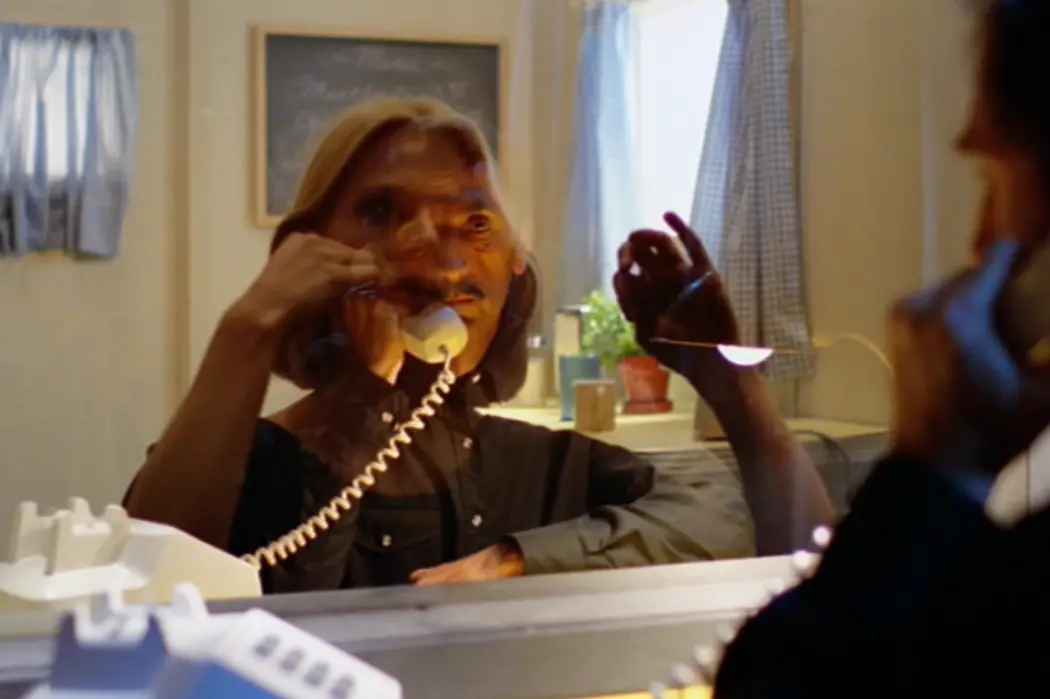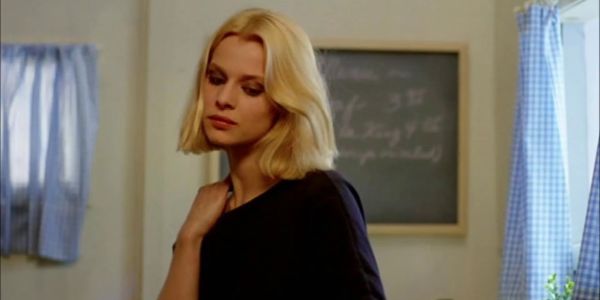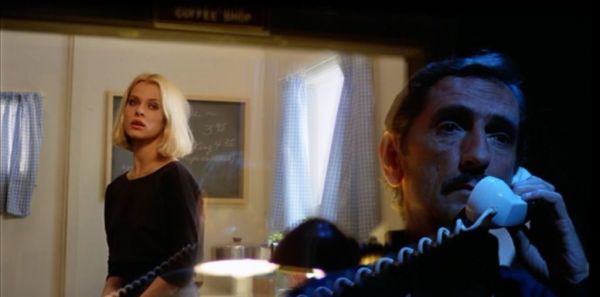Revisiting PARIS, TEXAS: How Wim Wenders Deconstructs Fragmented Memories

Monique Vigneault is a Mexican-Canadian film critic. She regularly covers…
A few weekends ago, the TIFF Lightbox put on a special screening of Wim Wenders’ 1984 Palme d’Or winner, Paris, Texas, which was a perfect excuse to revisit the classic Arthouse Western. The film’s cult following among cinephiles is unsurprising—its provocative commentary on the American dream, familial constructs, and the nature of memories surge with the kind of tragic melancholy intrinsic to art film.
The screenplay, co-written by Sam Shepard and L.M. Kit Carson, centres around Travis (Harry Dean Stanton), a man who—after disappearing four years ago—sets out to reunite his family, torn apart by the effects of poverty, alcoholism, and loving someone too much. “Paris, Texas” is unique because it’s a character study of the anti-hero, of the fallen classic Western hero, adapted for modern America. Wenders examines the post-Cold War America, through a fatalistic exploration of Travis’ decline from the expectations of the American dream.
The opening shot shows Travis wandering across the West Texas desert. After four absent years and a bout of amnesia, his brother hesitantly reunites him with his eight year old son, Hunter (Hunter Carson) in Los Angeles. The two soon embark on a road trip across the State of Texas in search of Hunter’s mother, Jane. They soon track her down in a run-down strip club in Houston, Texas, and what ensues is a portrait of a broken family trying to stitch itself back together.

While plot in Paris, Texas is sophomore at best, the film continues to capture the adoration of moviegoers. To many, like The New Yorker’s esteemed Richard Brody, the movie could be characterized rather flatly as, “a bad movie.” Paris, Texas is far from being a perfect film; it’s lengthy, at times even painstakingly slow, and sprinkled with a myriad of flaws when dealing with its heavy themes.
A troubling aspect of the film is Wenders’ one-dimensional portrayal of Jane (Nastassja Kinski), which banks heavily on the shallow aestheticism of the manic pixie dream girl trope. All viewers know of her is that she’s Hunter’s mother and Travis’ ex-wife, and that financially, she’s been backed into a castrating occupation as a peep show stripper. There’s a lot of inherent tragedy in her reality, and she is arguably one of the most interesting characters in Paris, Texas.
However, Wenders shows no interest in delving further into her complexities and nuances. He’s interested wholly in the superficial cliche. Viewers see her only through this lens, getting glimpses and slivers of her character only through Travis’ gaze and narrative. It’s only in the last few sequences in which she’s given a spot in the screenplay where she’s allowed some emotional agency.

Sartorially, Jane’s character continues to be at the forefront of fashion—as a muse for many fashion designers—costume designer Birgitta Bjerke styles her in a wistful, classic mohair sweater, coupled with the tousled shoulder length hair and dramatic kohl eyeliner. Superficially, her character is striking, yet her alluring character is overshadowed by Wenders’ preoccupation with Travis.
Another issue, one so pervasive in the film’s very fiber—is it’s romanticization of everything, particularly the dysfunctional relationship between Travis and Jane.
If there are so many unremarkable plot elements, what is it then, that sprung it to win the most prestigious award in the world of cinema? I attribute Wenders’ success in Paris, Texas down to one, unflinching factor: nostalgia.
Nostalgia as a plot device
What Wenders gets right is not the complex storyline—rather, it’s his telling of a universal one. He highlights the underscoring idea that memories are malleable, lost and fragmented within ourselves. Through Travis, Jane and Hunter’s discombobulated storyline, Wenders shows the different ways in which nostalgia manifests itself. That’s what’s so remarkable about the film: it’s the examination of the universal sadness one feels when things of the past ultimately fade away, and that same human refusal to let things go. The driving theme of nostalgia is exemplified through all the sensory aspects of the film—from the cinematography, colour palette and score, down to the sartorial style.
Paris, Texas is a slow burn, at almost three hours long. Viewers only hear the first bit of dialogue after the first half-an-hour. This element, if framed differently, could have failed had Wenders not used it with the intention to create a tragic sense of melancholy. He does this through long shots of characters walking across a barren wasteland, driving down water-washed streets, or gazing at their own reflection in the mirror of a roadside motel.
In these moments of stillness, director of photography, Robby Müller, achieves a feeling of nostalgia through a tapestry of sensory images. The colour palette is muted, sprinkled with bright, water-washed hues to make characters stand out in wide, expansive shots. In the initial sequence, a downtrodden and lost Travis stands out among the vast beige of the desert, with his bright red baseball cap.

One of the most remarkable cinematic moments in the film is when Wenders turns the act of filmmaking into a plot device. Travis’ memory is tested when he’s shown a roll of Super 8 film with him, Jane, Hunter, and the whole family on the coast one summer. Afflicted by amnesia, Travis rediscovers his love for Jane one frame at a time. This scene has remained a classic cinematic sequence because of its timeless portrayal of human memories.
While more on the minimalist side, the soundtrack creates the backdrop of Travis’ story. Ry Cooder’s score in Paris, Texas is a mix of old western tunes, that borrow from gloomy Ranchera guitar ballads like “Cancion Mixteca.” This sort of weepy guitar tune is present all throughout the movie, looming around Travis like the ghost of his past.
Wenders’ artful screenplay foreshadows many of the prevalent motifs that are visually explored, resulting in a cacophony of melancholy—each element bouncing off each other to omit an emotion many of us don’t even understand.
Despite the fact that Wenders’ characters are portrayed in such a flawed light, I find the most alluring element of the film is its inherent tragedy. Wenders doesn’t shy away from showing the sheer sadness of the situation. The dialogue is honest and curt, flourishing in the rare instances when it mirrors real life. This is exemplified in the final sequence between Jane and Travis.
Devastating lines like, “I wanted to see him so bad that I didn’t dare imagine him anymore. Anne kept sending me pictures of him, until I asked her to stop. I couldn’t stand the pain of seeing him grow up and missing it,” cling with viewers long after the credits roll.
By employing simplistic, straight-to-the-point dialogue, Shepherd and Carson create realistic and tragic monologues between the characters. Jane delivers perhaps some of the best lines of the film during the final few scenes, through lines like, “I hear your voice all the time. Every man has your voice.”
Despite it’s visceral sadness, the film ends on a bittersweet high note, leaving the viewers with the very real, palpable feeling of melancholy. By the end, each of these artistic elements pieced together create a convincing pastiche of the frenetic nature of nostalgia.
What are your thoughts on Paris, Texas? Let us know down below!
Does content like this matter to you?
Become a Member and support film journalism. Unlock access to all of Film Inquiry`s great articles. Join a community of like-minded readers who are passionate about cinema - get access to our private members Network, give back to independent filmmakers, and more.
Monique Vigneault is a Mexican-Canadian film critic. She regularly covers world cinema on the festival circuit.












